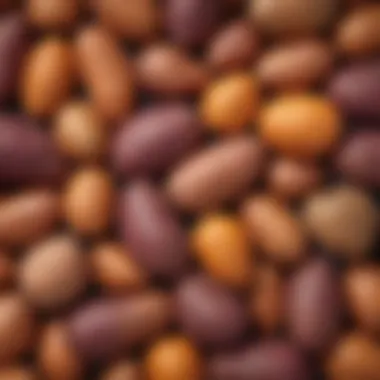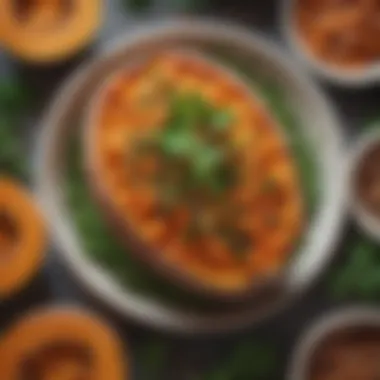The Case of Sweet Potatoes: An In-Depth Study


Intro
Sweet potatoes are not simply a food item; they are a rich tapestry of history, nutrition, and culture. Across the globe, they serve as a fundamental source of sustenance, embraced for both their versatility in the kitchen and their nutritional benefits. This article will explore various aspects that make sweet potatoes significant, particularly in contemporary culinary practices.
Their vibrant colors, ranging from orange to purple, signify their diverse types and potential uses. Sweet potatoes are often overlooked in favor of other vegetables, yet they deserve attention for their unique qualities. By examining their nutritional profile, culinary applications, and the cultural significance they hold in different regions, we aim to paint a complete picture of sweet potatoes.
With a growing interest in sustainability and health trends, sweet potatoes have found a renewed spotlight. We will discuss their role in these fields, underscoring how they can contribute to healthier diets and more sustainable food systems. This exploration seeks to inspire culinary enthusiasts and create a deeper appreciation for sweet potatoes as a staple ingredient.
Recipe Overview
Brief Summary of the Recipe
One of the most popular ways to prepare sweet potatoes is roasting. Roasting enhances their natural sweetness and brings out a delightful caramelization that can complement various flavors. This method is straightforward yet rewarding, making it ideal for both novice cooks and experienced chefs.
Key Ingredients and Tools Needed
To successfully roast sweet potatoes, a few key ingredients and tools are essential:
- Sweet potatoes: Choose firm and fresh ones.
- Olive oil: Provides a perfect base for roasting.
- Salt and pepper: Enhances the flavor.
- Optional spices: Such as cinnamon or paprika for added depth.
- Baking sheet: For even cooking.
- Parchment paper: Optional, for easy cleanup.
Intro to Sweet Potatoes
Sweet potatoes are not just a common ingredient; they are a significant part of various culinary traditions worldwide. Understanding sweet potatoes involves exploring their rich historical context and unique botanical characteristics. This knowledge not only enriches culinary practices but also enhances appreciation for a food source that is versatile, nutritious, and culturally significant.
Historical Context
The history of sweet potatoes dates back thousands of years. Originally domesticated in Central and South America, they have become a staple food in many countries across the globe. Archaeological evidence suggests that sweet potatoes were cultivated as early as 500 BCE in Peru. This root vegetable then spread to other regions, including Africa and Asia, through trade and exploration.
In Africa, sweet potatoes adapted nicely to the local environment, becoming a vital food source. They were particularly significant during times of famine or food scarcity. Furthermore, the 16th century saw the introduction of sweet potatoes to Europe, where they gained popularity in various cuisines. Over time, they have been integrated into traditional dishes, showcasing their adaptability and importance.
Today, sweet potatoes continue to play a role in food security and agricultural practices around the world. Their ability to grow in diverse conditions makes them a reliable food source, benefiting many communities.
Botanical Characteristics
Sweet potatoes belong to the morning glory family, Convolvulaceae. They are scientifically known as Ipomoea batatas. This plant bears not only the edible root but also green, heart-shaped leaves that are also consumable.
The root, which we commonly refer to as the sweet potato, varies in color, texture, and size. The most common varieties found in grocery stores include orange, white, and purple sweet potatoes. Each type presents different flavors and nutritional profiles. For example, orange sweet potatoes are rich in beta-carotene, a precursor to vitamin A.
Sweet potato plants thrive in well-drained soil and require full sunlight to grow properly. Their growth cycle typically spans three to five months, depending on the variety. This adaptability allows them to flourish in a range of climates, further cementing their role as a staple in various cultures.
"Understanding the historical and botanical aspects of sweet potatoes enhances appreciation for their culinary uses and implications in sustainable agriculture."
Overall, sweet potatoes are more than just a hearty vegetable. They are a symbol of resilience in food culture, providing nourishment and showcasing the ingenuity of various cuisines. Their historical significance and botanical properties lay the groundwork for exploring their nutritional profile and culinary versatility in subsequent sections.
Nutritional Profile


The nutritional profile of sweet potatoes underscores their significance in the culinary landscape. This section will elaborate on the vitamins and minerals these tubers provide and explore the health benefits that contribute to their rising popularity among consumers and chefs alike.
Vitamins and Minerals
Sweet potatoes are rich in essential vitamins and minerals. They boast a high content of Vitamin A, primarily in the form of beta-carotene, which is crucial for maintaining healthy vision and supporting immune function. One medium sweet potato can supply more than 400% of the daily recommended intake of Vitamin A.
Additionally, these root vegetables are good sources of Vitamin C, which aids in the healing process and supports skin health. They also contain important B vitamins, such as B6, which plays a role in metabolism and brain health.
In terms of minerals, sweet potatoes provide potassium, which is vital for maintaining heart health and regulating blood pressure. Magnesium is also present, contributing to muscle and nerve function as well as energy production.
"Sweet potatoes are a powerhouse of nutrients, making them a staple in many healthy diets."
Health Benefits
The health benefits of sweet potatoes extend beyond their impressive nutritional profile. Consuming these tubers can lead to numerous positive health outcomes. Since they are high in fiber, sweet potatoes can support digestive health and promote a feeling of fullness, which can be beneficial for weight management.
Moreover, the glycemic index of sweet potatoes is lower compared to regular potatoes. This characteristic makes them a more suitable choice for individuals seeking to manage blood sugar levels. Their antioxidants combat oxidative stress, potentially lowering the risk of chronic diseases such as heart disease and certain cancers.
Including sweet potatoes in your diet may also improve skin health, given their Vitamin A and antioxidant content. Furthermore, their versatility in the kitchen allows for creative application in various recipes, making them an enjoyable addition to meals.
The nutritional richness and health benefits of sweet potatoes exemplify their value not only as a food item but also as a critical ingredient in the pursuit of a balanced diet.
Culinary Versatility
Culinary versatility is an essential aspect of sweet potatoes that warrants deep examination. Their adaptability across various cuisines and dishes makes them a valuable ingredient. Recognizing how sweet potatoes can be transformed through different cooking techniques enhances appreciation for their role in modern kitchens. Not only do they offer diverse flavors and textures, but their nutritional profile also remains intact through many cooking methods. This section explores these methods, delving into their specific contributions.
Cooking Techniques
Baking
Baking sweet potatoes is a straightforward and popular method. This technique allows for a natural sweetness to be amplified, creating a rich flavor. When baked, the skin becomes crisp while the flesh remains soft, providing a satisfying texture. This method is beneficial for those seeking a healthy cooking alternative without added fats. Some may find the long cooking time a disadvantage, as it can take around 45 minutes to an hour to fully bake. However, the ease of preparation makes it a go-to choice for many.
Boiling
Boiling sweet potatoes is another common cooking method. This technique is quick and simple. By boiling, nutrients can be somewhat retained if the cooking time is controlled. The key characteristic of boiling is its speed; it takes approximately 20 to 30 minutes. This method allows sweet potatoes to be easily incorporated into various dishes, such as soups or mash. A disadvantage is that, without proper seasoning, boiled sweet potatoes might lack flavor and depth.
Roasting
Roasting sweet potatoes is favored for creating caramelization. This technique helps to deepen flavors, making it ideal for savory and sweet dishes alike. Roasting usually takes between 25 to 45 minutes, depending on the desired crispiness. One unique feature of roasting is the ability to add spices or herbs that can enhance the overall taste. However, monitoring is necessary to prevent burning, particularly if cut into small pieces.
Frying
Frying sweet potatoes yields a crispy exterior with a tender inside, which many find appealing. The frying process produces a delightful texture that is often sought after in dishes like sweet potato fries. This technique can be viewed as less healthy due to the fat content from oils and the potential for increased calories. However, the indulgence of texture and taste often justifies the method's occasional use. Care should be taken with oil choice and temperature to ensure optimal frying results.
Recipe Ideas


Sweet Potato Casserole
Sweet potato casserole is a classic dish often enjoyed during holidays. It offers a perfect balance of sweetness from the potatoes combined with richness from ingredients like butter and sugar. This dish is beneficial as a crowd-pleaser at family gatherings. One unique feature is the topping, usually made from pecans or marshmallows, which adds a crunchy texture. Drawbacks may include its high sugar content, making it less suitable for regular consumption.
Mashed Sweet Potatoes
Mashed sweet potatoes are a versatile and comforting side dish. They can be easily customized with flavors such as cinnamon or garlic. The key characteristic of this dish is its creamy texture, enhanced by ingredients like cream or butter. This makes it a popular choice for accompanying many meals. A disadvantage could be the potential for it to become too rich if overly creamy ingredients are used.
Sweet Potato Fries
Sweet potato fries present a healthier alternative to traditional fries. Their unique flavor profile combines sweetness with a crispy texture. One of the appealing aspects of sweet potato fries is their versatility - they can be seasoned in various ways to suit different palates. However, achieving the perfect crispiness can be a challenge, often requiring precise cooking techniques.
Sweet Potato Soup
Sweet potato soup is a comforting option for colder months. This dish combines the natural sweetness of sweet potatoes with various spices, creating a rich, satisfying flavor. The health benefit of this soup is high nutrient content, especially when made with additional vegetables. However, it may not appeal to everyone due to its distinct sweetness compared to more traditional savory soups.
Cultural Significance
The cultural significance of sweet potatoes is profound and varied. Globally, these tubers are not just food; they are woven into the fabric of many cultures, traditions, and histories. They serve a role beyond mere sustenance, often symbolizing identity and community. Understanding this significance offers insights into how sweet potatoes can influence culinary practices and social structures.
Global Varieties
Sweet potatoes exist in numerous varieties, each with its unique characteristics shaped by the regions where they are cultivated. Some of these varieties include:
- Batata: Known for its smooth texture and sweet taste. It is commonly found in Spain and is often used in desserts.
- Hannah: This variety is characterized by its pale yellow skin and sweet, moist flesh. It is often used in traditional American dishes.
- Purple Sweet Potato: Popular in Asian cuisines, especially in Japan, the purple variety has a starchy consistency with a slightly nutty flavor.
These varieties represent the adaptation of sweet potatoes to various climates and soil types, making them a versatile crop around the world. Each variety provides a different taste and texture, revealing the tuber's adaptability and global appeal.
Traditional Dishes
Across cultures, sweet potatoes are featured in a multitude of traditional dishes. Some noteworthy examples include:
- Sweet Potato Pie: A beloved dessert in the United States, especially during holidays, showcasing the sweet potato's versatility in baked goods.
- Bammy: A Jamaican dish made from grated cassava, sometimes incorporated with sweet potato, usually served with fish.
- Korean Sweet Potato Noodles (Japchae): An essential part of Korean cuisine, this dish uses sweet potato starch to create chewy noodles mixed with vegetables.
- African Groundnut Stew: This dish features sweet potatoes blended with nuts and spices, reflecting the resourcefulness of ingredients in local farms.
These dishes exemplify how sweet potatoes have been integrated into culinary traditions, enhancing flavors and providing nourishment. They also highlight sweet potatoes' role as a cultural symbol, uniting communities through shared meals and practices.
Sustainability and Agriculture
Sustainability and agriculture play a critical role in the discourse surrounding sweet potatoes, particularly in light of their increasing popularity in various cuisines. As the world grapples with the challenges of food security and climate change, the cultivation of sweet potatoes emerges not only as a vital agricultural practice but also as a commitment to sustainable food systems. This section will explore the growing practices and environmental impact associated with sweet potato farming.
Growing Practices
Sweet potatoes are grown in a range of climatic conditions, but they thrive best in warm weather. They prefer well-drained soils that are rich in organic matter. Different regions employ multiple techniques to maximize yield and maintain soil health. Common practices include:
- Crop Rotation: Rotating sweet potatoes with legumes and other crops can enhance soil fertility and reduce pest buildup.
- Mulching: This involves covering the soil surface to retain moisture, suppress weeds, and provide a habitat for beneficial organisms.
- Organic Fertilizers: Utilizing compost and natural amendments helps maintain soil structure and nutrient availability without the harmful effects associated with synthetic chemicals.


These practices not only promote better growth but also continue the trend towards sustainable farming that minimises resource depletion while ensuring a reliable food supply.
Environmental Impact
The environmental impact of sweet potato cultivation presents both positive and negative aspects. On one hand, sweet potato farming has the potential to contribute to sustainable agriculture by:
- Erosion Control: The extensive root system of sweet potatoes helps anchor the soil, reducing erosion in areas susceptible to land degradation.
- Biodiversity: Incorporating sweet potatoes into diverse cropping systems can enhance biodiversity, as they can coexist with other crops and support various wildlife.
However, it is essential to carefully consider water management and pesticide use. Excessive water usage in irrigation can lead to depletion of local water resources. Meanwhile, the application of chemicals in farming can affect local ecosystems and pollinators.
"Sustainable sweet potato agriculture offers a dual benefit: it supports farmer livelihoods while contributing to ecological health."
Current Trends in Cooking with Sweet Potatoes
Sweet potatoes have increasingly gained attention in contemporary culinary circles. Their versatility extends beyond traditional recipes, adapting readily to current health-conscious and innovative cooking trends. Examining these trends provides valuable insights into the evolving use of this nutritious root vegetable. This section highlights how sweet potatoes fit into health trends and the innovations emerging in recipe development.
Health Trends
In recent years, health trends have notably emphasized the inclusion of nutrient-dense foods in diets. Sweet potatoes, recognized for their rich content of vitamins A and C, alongside fiber, have become staples in various health-oriented diets. Their natural sweetness and versatility allow them to seamlessly integrate into different meal plans, supporting wellness without compromising flavor.
Moreover, the rise of plant-based diets and alternatives has propelled sweet potatoes into the spotlight. They offer an excellent substitute for unhealthier carbohydrates found in refined grains. The adoption of sweet potatoes into gluten-free diets showcases their potential to cater to a wide range of dietary restrictions, attracting diverse audiences.
"Sweet potatoes can support a balanced diet, providing essential nutrients that promote overall health."
This trend is reflected in the increasing number of recipes that highlight sweet potatoes in salads, bowls, and even smoothies. Health-conscious consumers often seek out these recipes, understanding the benefits of incorporating sweet potatoes into their meals. Additionally, their low glycemic index positions sweet potatoes as an ideal choice for those managing blood sugar levels. This aspect makes them increasingly popular among individuals with diabetes or those aiming for weight management.
Recipe Innovation
The culinary landscape has witnessed substantial innovation in how sweet potatoes are prepared and presented. Chefs and home cooks alike are experimenting with sweet potatoes in unexpected ways, leading to the creation of diverse dishes that go beyond traditional expectations. This innovation is driven by a desire to elevate the humble sweet potato into gourmet fare.
Some emerging recipe ideas include utilizing sweet potatoes to create:
- Sweet potato gnocchi
- Sweet potato sushi rolls
- Sweet potato pancakes
- Sweet potato hummus
These inventive approaches spotlight the adaptability of sweet potatoes in various cuisines, encouraging creativity in the kitchen. Additionally, incorporating global flavors into sweet potato-based recipes allows for cross-cultural culinary experiences. For example, using spices commonly found in Indian or Middle Eastern cuisines can transform sweet potato dishes, enhancing their appeal.
As food enthusiasts continue to explore these trending recipes, the overall perception of sweet potatoes is shifting. They are increasingly recognized not just as a staple side dish but also as a dynamic ingredient perfectly suited for modern cooking trends. This evolution demonstrates that sweet potatoes can accommodate various palates and lifestyles, making them highly relevant in today's culinary world.
Ending
This article has explored the various dimensions of sweet potatoes, shedding light on their significance in culinary arts and beyond. Sweet potatoes are not merely a versatile ingredient; they play a crucial role in nutrition, culture, and sustainability. The exploration into their nutritional profile reveals that they are rich in essential vitamins and minerals, making them a health-conscious choice for individuals of all ages. Furthermore, the culinary versatility discussed indicates how sweet potatoes can adopt various forms, appealing to diverse palates and preferences.
The Future of Sweet Potatoes in Culinary Arts
Looking ahead, sweet potatoes are poised to capture even more attention in the culinary landscape. As health trends continue to emphasize whole foods and natural ingredients, sweet potatoes fit perfectly into this narrative. Their unique texture and sweet flavor can enhance both traditional and innovative recipes.
- Health Trends: There is a growing consumer demand for plant-based diets. As individuals become more aware of their choices, sweet potatoes' nutritional benefits are likely to make them a staple in many kitchens.
- Recipe Innovation: Chefs and home cooks alike are experimenting with sweet potato in unexpected ways, creating dishes such as sweet potato gnocchi and even sweet potato pizza crusts. This trend is indicative of a larger movement that favors creativity in food preparation while enhancing flavor and nutrition.
"The evolution of how we use sweet potatoes reflects a broader change in culinary arts, where innovation meets tradition."
As sustainability becomes an important focus in agriculture, the cultivation practices surrounding sweet potatoes also promise to transform. Their ability to grow in diverse conditions offers significant potential for local farmers and sustainable food systems. By minimizing environmental impact, sweet potatoes can be celebrated not just for their taste but also for their role in promoting a more sustainable food source.







